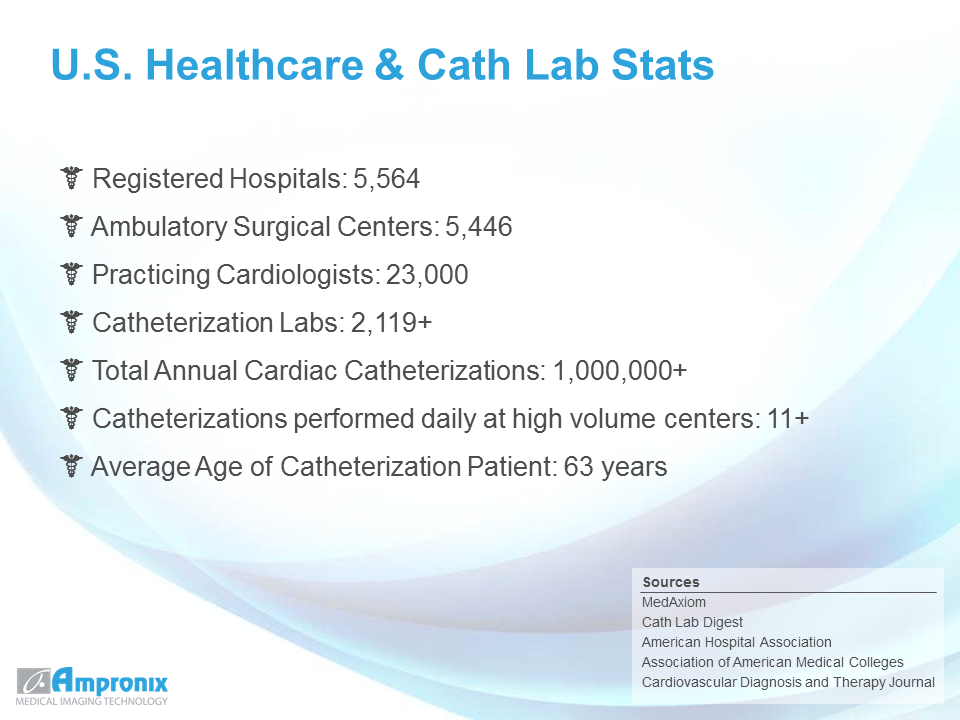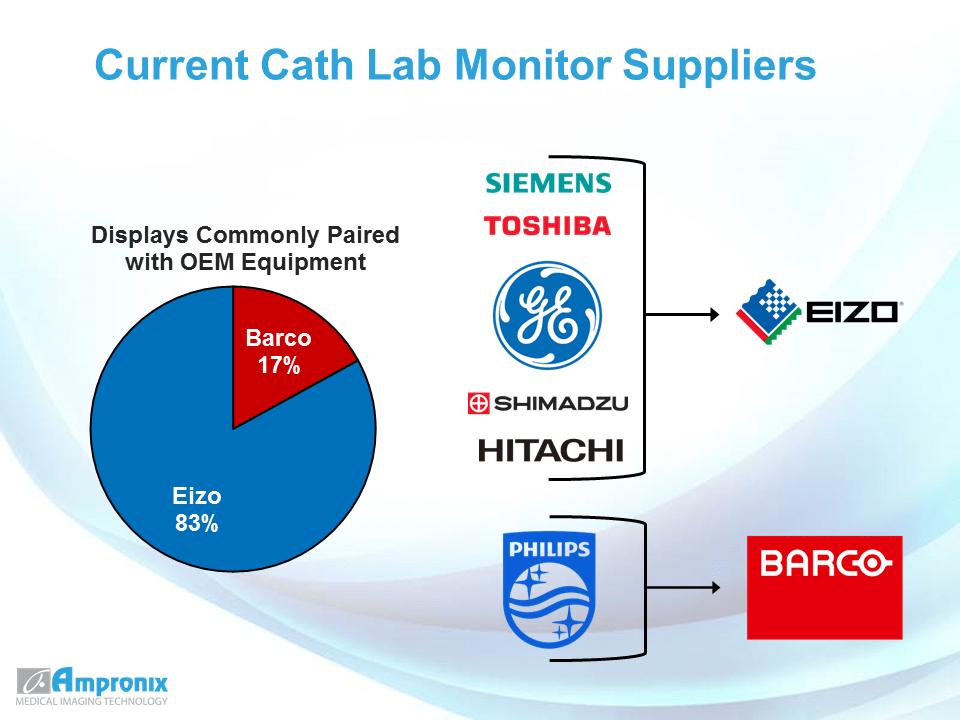Provisional Patent
To ensure our ideas are protected, Ampronix files a patent after establishing a novel product. Upon receiving a certified patent, Ampronix is granted legal confirmation and protection to that original technology, allowing the company unrestricted access to create unlimited products that pertain to that particular patent.
With granted patents, Ampronix is the sole founder and is entitled to legal protection should any entity attempt to duplicate it. The ideas and products associated with provisional patents are protected for a year, after which, Ampronix may choose to pursue a permanent patent.
HYBRIDPIXX
Ampronix presents the HYBRIDPIXX Video
BACKGROUND
A Catheterization Laboratory is an instrumentally vital aspect of any hospital or healthcare facility. Commonly referred to as cath lab, this type of examination room is equipped with diagnostic imaging technology to give physicians visual access to chambers and arteries of the heart. In these spaces, a team of physicians perform life-saving procedures including coronary angiography, catheterization, balloon angioplasty, percutaneous coronary intervention, congenital heart defect closure, stenotic heart valves, and pacemaker implantations.
These procedures would not be established without the appropriate technology to facilitate the imaging process. In fact, cath lab operations depend completely on medical displays, which allow physicians to visualize a patient internally and perform the necessary procedure.
Although there have been considerable technological advancements in efficient cath lab construction, the dependence on X-ray imaging has persisted through every transition. From the decision to purchase analog or digital modalities, to choosing a single or bi-plane system, there are endless customization possibilities. A typical cath lab consists of a C-arm, image intensifier, X-ray tubes, and several displays.
Advantageously, the digital age has ushered in an era of improvements to imaging technology that emit less radiation while simultaneously give physicians visual clarity. The adoption of CRT monitors in the cath lab inherently changed the way in which they ran.
In early cath labs, all information was conveyed through film. The X-rays utilized were high-dose, produced low-quality images, and were printed on 16-mm or 35-mm film. Radiologists would spend almost their entire day in darkrooms to process images while ample storage space was filled with boxes of film.
With the implementation of picture archiving and communication systems (PACS), the transition from analog to digital technology was cemented. PACS is an all-in-one program that provides electronic storage, retrieval, distribution, and presentation of radiology images.
Following CRT displays was the advent of LCD screens. Many upgraded to these monitors due to their slim and portable design, along with higher resolution imagery. In the cath lab, there are typically four to six CRT or LCD displays in use. Whereas a majority of the screens are utilized for hard images, one is always used to monitor the physiological attributes of a patient, like their heart rate or blood oxygen levels.
We are witnessing yet another transition in medical monitors, as many professionals are updating from LED displays to ultra-high definition 4K technology. Many healthcare facilities have already, or are currently, in the process of upgrading their medical displays to this resolution which provides a level of visibility previously unknown to physicians. During critical surgeries and procedures, increased clarity and sharper details can mean the difference between saving and losing a life.
Instead of making use of four to six displays, many are instead opting to update their displays with one large UHD 4K display. When a UHD display is combined with a video manager, it can then be customized with a variety of layout options and editing tools such as magnification and image scaling. The design is easier to use and provides a higher resolution, making its adoption an easy choice as it facilitates precise procedures and minimally invasive surgeries.
Although the advent of this technology has fostered improved patient care, the concessions made could prove to be detrimental and may demand considerable attention. Specifically, departing from the LED model to the 4K display system introduces issues with maintenance and safety.
Most cath labs use four to six displays simultaneously, and there are often preventative measures in place that guarantee a backup option should a monitor burn out. In critical imaging procedures, mere seconds without visibility become crucial moments. Single display cath labs are especially susceptible to all of these associated risks.
To solve this issue, some displays are equipped with back-up monitors that fold-out if needed. However, this is a sacrifice that presents limited visual acuity. When this type of situation unravels, the entire procedure is halted and the patient must be sutured up as technicians attempt to remedy the problem.
Furthermore, any display failure renders an entire cath lab useless until a replacement or repair solution is provided. For example, in March of 2016, a patient underwent a heart catheterization procedure and was almost compromised when misconfigured antivirus software caused a HEMO monitor to go black and lose connection. The subsequent five minute blackout left the monitor inoperable, calling the dependability of all monitors into question when implemented in critical environments. Moreover, the National Center for Biotechnology Information- U.S. National Library of Medicine reports that monitor malfunctions make up thirty percent of equipment related complications in the U.S.
SOLUTION
There are many variables healthcare providers must consider when deciding what upgrades should be made. With cath lab procedures in mind, we created HYBRIDPIXX to facilitate improved, safe, and reliable care without compromise.
The pending patent HYBRIDPIXX touts an ingenious design that garners all the advantages of the 4K UHD display, while mitigating the dangers associated with a single large display. The mount holds two 58 inch displays in place, so if the primary display fails, an identical back-up display is ready. With a modular connection, the wireless display can be easily switched in under a minute. The aforementioned cath lab display blackout would not have hindered surgery if the physicians had been able to use the HYBRIDPIXX monitors, as it allows physicians to implement an immediate alternative plan in these high-risk scenarios.
HYBRIDPIXX has a streamlined design which makes the display easily replaceable, simplifying the maintenance process. Furthermore, the decreased reliance on servicing makes the HYBRIDPIXX a cost-effective solution because a biomedical engineer is the only individual needed to replace the monitor.
Available in 58 inches, the 4K UHD monitor can be employed in both analog and digital cath labs. With the option to purchase our video manager, all the benefits of customizable layouts and modification are feasible. Additionally, the screen can be utilized in a variety of spaces, including hybrid operating rooms that facilitate both surgical and interventional procedures.
Ampronix is dedicated to providing superior solutions to medical professionals that come without compromise. With our latest creation, HYBRIDPIXX, we have taken a step forward in our goal to facilitate optimized patient care and improved physician workflow.
Current US Market Overview


About Ampronix
Ampronix is a renowned authorized master distributor of the medical industry’s top brands as well as a world class manufacturer of innovative technology. Since 1982, Ampronix has been dedicated to meeting the growing needs of the medical community with its extensive product knowledge, outstanding service, and state-of-the-art repair facility. Ampronix prides itself on its ability to offer tailored, one-stop solutions at a faster and more cost effective rate than other manufacturers. Ampronix is an ISO & ANSI/ESD certified facility. To learn more go here.
Inquire about how we can help you with your OEM needs at: info@ampronix.com

